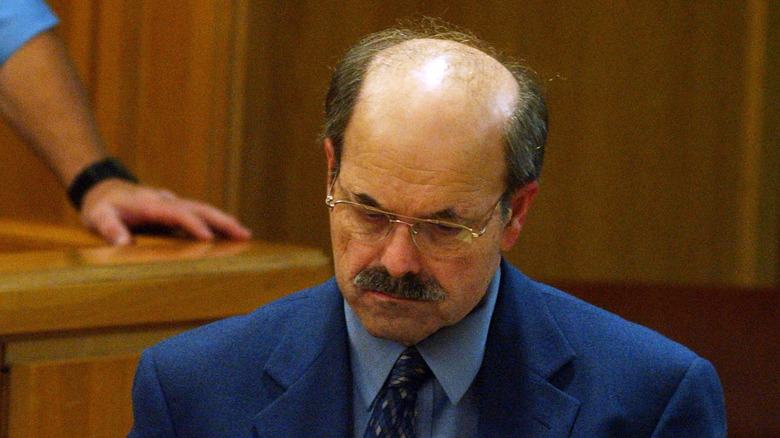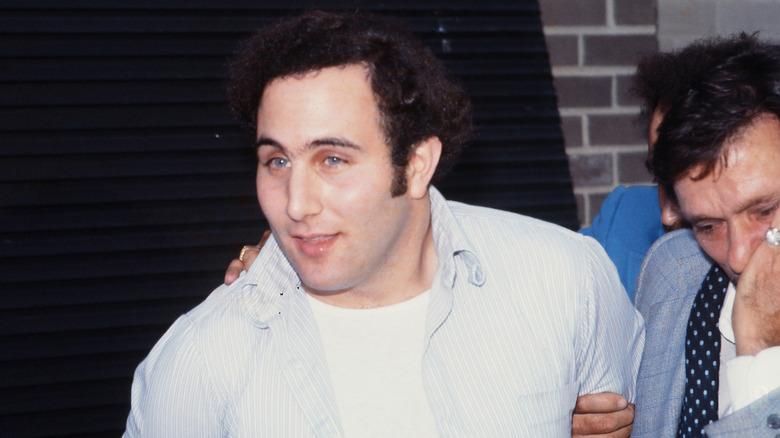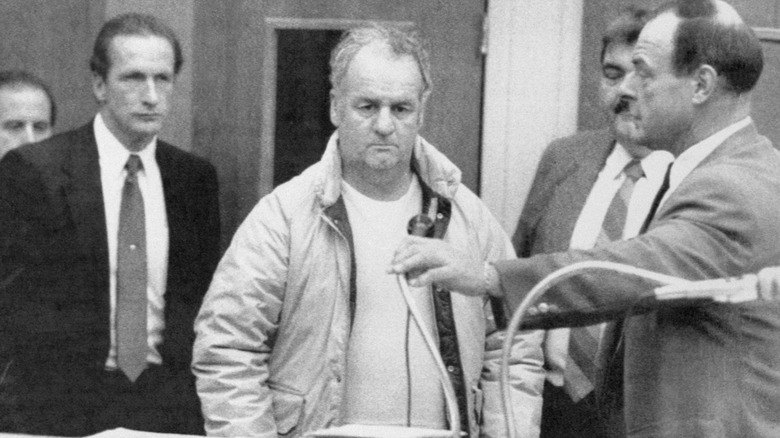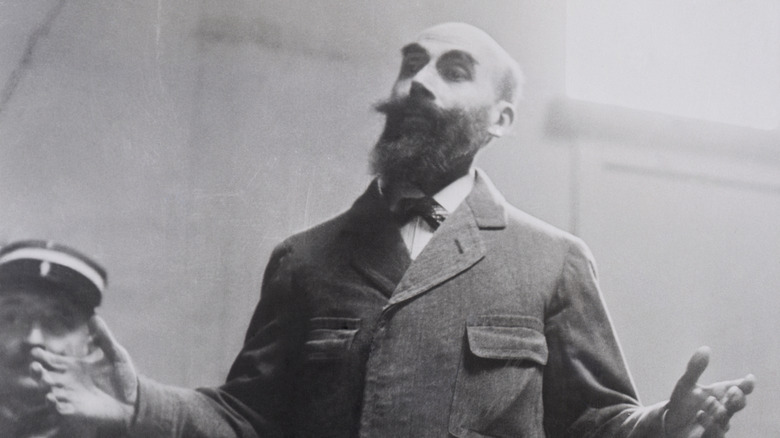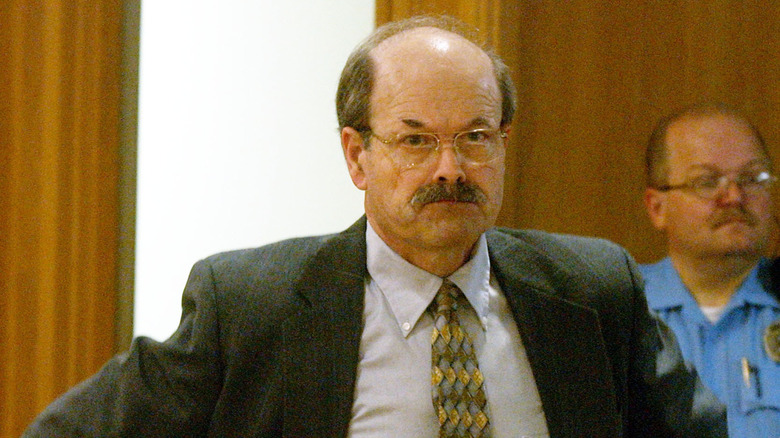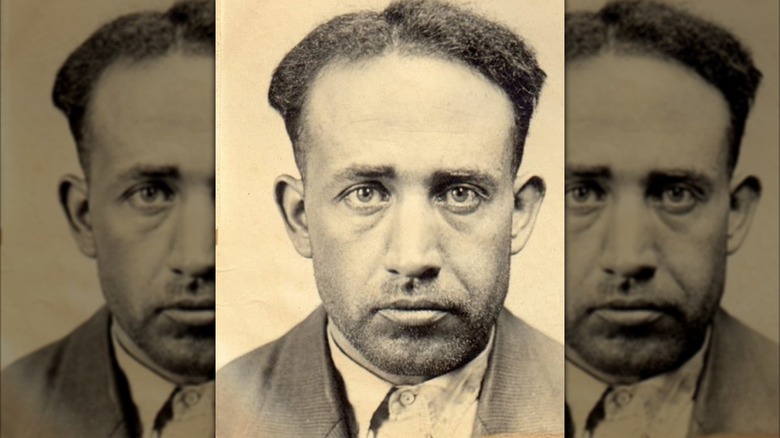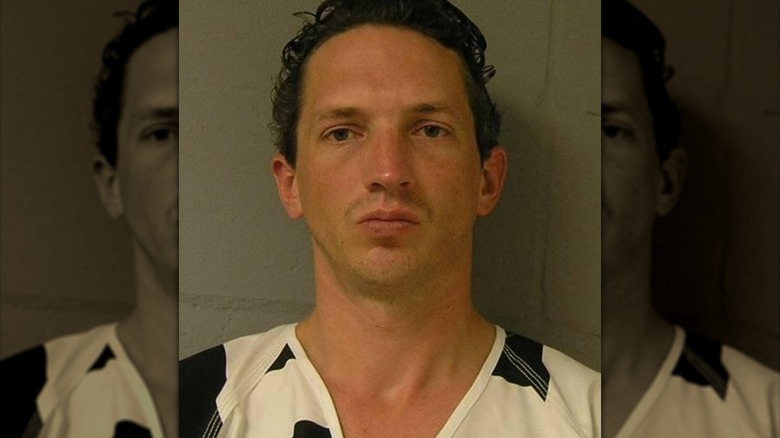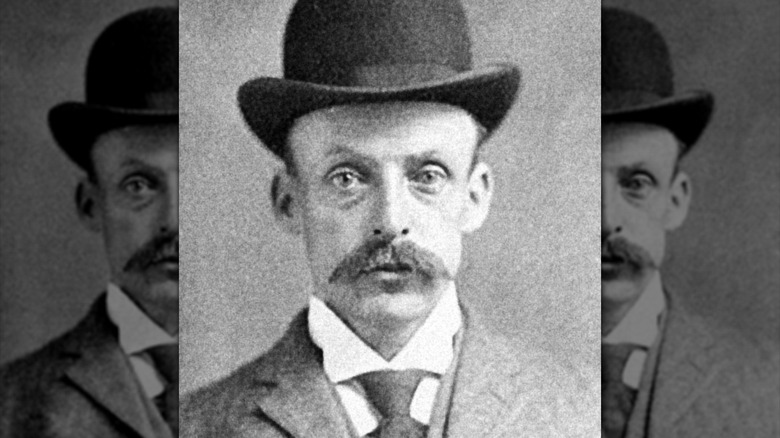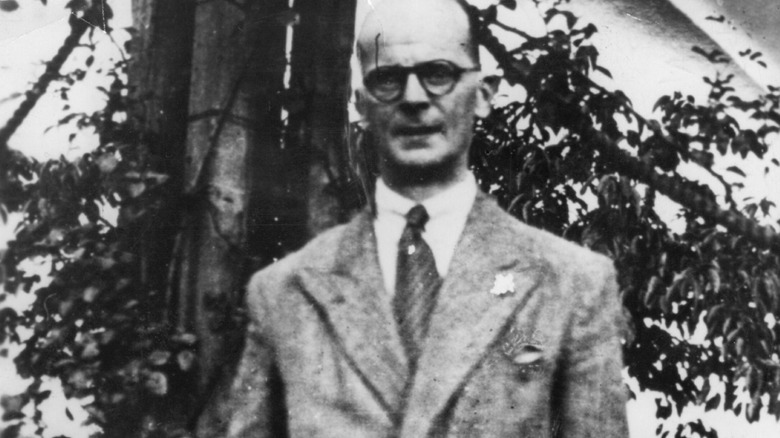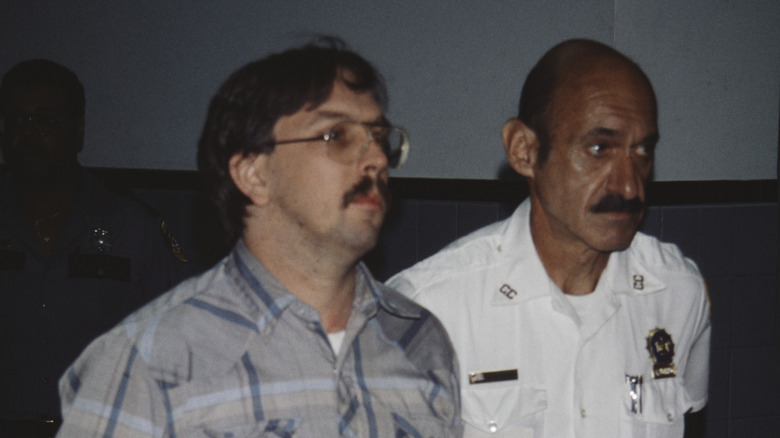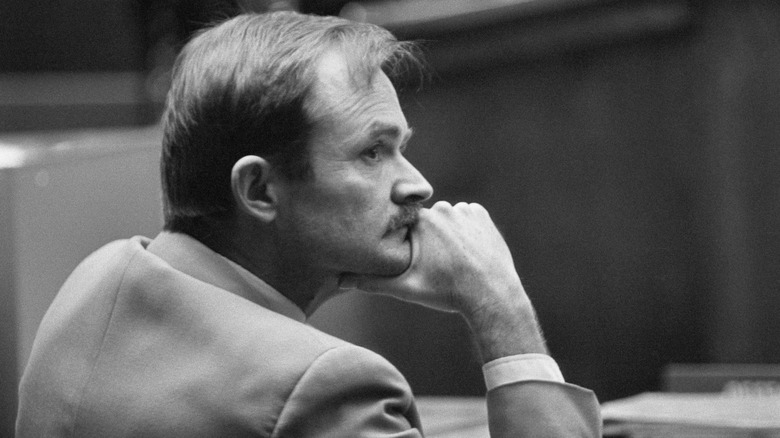Serial Killers Caught By Stupid Mistakes
We may receive a commission on purchases made from links.
Serial killers are often masters of covering their tracks and throwing the authorities off their scent so they can continue their heinous crimes again and again. As a matter of fact, there are several serial killers who vanished and were never found, which makes you want to sleep with the windows shut and one eye open forever. Sometimes, though, whether it be due to arrogance, overconfidence, or a minor unexpected slip-up, they give themselves away in the stupidest manner possible.
It's a good thing, of course, since they deserve to be behind bars — any way in which this happens faster should be considered a win (or blessing) by society. Not everything needs to be a high-speed chase or dash through the woods like in the television shows or movies. Occasionally, it's a parking ticket or bloody haircut that raises enough suspicion for the authorities to investigate and act. With that being said, let's take a look at the ridiculous mistakes that resulted in the captures of notorious serial killers like David Berkowitz, Henri Désiré Landru, Arthur Shawcross, and John Christie.
David Berkowitz acted bizarrely in front of a passerby
David Berkowitz, the infamous serial killer known by the name "Son of Sam," terrorized New York City in the '70s. The former Army soldier embarked on a killing spree that left six dead and injured others as he toyed with authorities by sending letters to the press. In August 1977, he was captured by police. Not a moment too soon, according to Time, as he had planned a massacre at a nightclub.
By the time of his capture, police had been keeping a close eye on Berkowitz, who had been reported to the authorities by his neighbors for several peculiar incidents. Resultantly, his car and license plate were in the system. What tipped the case in the authority's favor was the testimony of Cacilia Davis, who had walked her dog on the night of Stacy Moskowitz's murder.
Davis recalled how Berkowitz sauntered past her, describing his walk as "like a cat," and said he was carrying something under his arm. She heard shootings a while later and recalled to police officers how she saw a cop issue a parking ticket to a vehicle situated in front of a fire hydrant not too far from the murder. The authorities checked all the parking violations issued that evening, with only Berkowitz's car coming up. What set off the alarm bells was that Berkowitz was 25 miles away from his home at that time of night. When the police approached him at his apartment, he came clean.
Arthur Shawcross was found pleasuring himself near a dead body
The case of Arthur Shawcross, also known as the Genesee River Killer, still stirs debate among people because of how many murders could have been prevented had he never been paroled to begin with. Though he assaulted and killed two young children in the early '70s, he arranged a plea deal to serve only 25 years for the one murder. Shawcross didn't serve his full sentence, though, as a few psychiatrists deemed that he was no longer a threat to society, so he was released after 14 years.
It didn't take too long for the bodies to start mounting up again after his parole. Police discovered mutilated bodies of sex workers and homeless people near the Genesee River, hence him receiving the nickname. The way in which Shawcross was captured, though, was outrageous, to say the least. In January 1990, state troopers observed Shawcross sitting in his car and pleasuring himself as he looked on at the corpse of one of his victims, June Cicero. This raised sufficient suspicion, needless to say.
Still, the question remains: How many victims did the serial killer Arthur Shawcross claim? According to his confessions, 13. However, some believe that he may have killed many more people.
Henri Désiré Landru kept a notebook with key details of his crimes
Henri Désiré Landru is one of France's most notorious serial killers and swindlers. He struck during the World War I era, killing at least 10 women and one of their sons. Landru's modus operandi involved scouring the lonely hearts columns in newspapers and reaching out to the women. Then, he would invite them to his villa, buying a one-way trip for them — and a round trip for him.
The disappearances, as well as a doctor claiming to have seen Landru disposing of large material in the pond, pushed police to investigate Landru as a person of interest. They found remains of human bones, as well as items of clothing, identity documents, and banking information of the missing women, on Landru's premises. However, the capper was the discovery of a notebook in which he kept stringent details about whom he met and at what time — and this coincided with the reported missing women and teenage boy. The belief was that Landru started off by swindling the victims before it escalated to murder.
According to the police, Landru had reached out to over 283 women via the lonely hearts ads. The police didn't track down all the people, with 72 unaccounted for. Whether this means Landru killed them or not, it'll never be known. Even though Landru remained defiant until the end, he was sentenced to death by guillotine in 1922.
Dennis Rader's metadata gave him away
Wichita, Kansas experienced a horror show from 1974 to 1991, as Dennis Rader, also known as the "BTK Killer," tortured and murdered 10 people during this period of time. The killer would taunt the authorities through letters, notes, and poems in which he admitted to and detailed his horrific crimes. After 1991, though, Rader slipped off the radar, and everyone feared he would become another serial killer whose true identity would never be discovered.
In 2004 — 30 years after his first killing — Rader resurfaced and sent clues, puzzles, and letters to local media outlets once more. Yet, it was this desire to communicate with authorities and the media in the new digital era that led to his capture. In one of his drops, he left behind a computer disk. The police's forensics team scanned the disk and tracked it back to the Christ Lutheran Church, where Rader served as president of the council.
As per The New York Times, Rader's pastor, Michael G. Clark, had allowed him to use the church's computer and printer since Rader stated his home device wasn't working. "What the investigators found, from what I understand, running that disk through scanning and processing, was that that disk had to have been in our computer," Clark said.
Earle Leonard Nelson's barber noticed blood on his head
Before John Wayne Gacy. Before Ted Bundy. Before David Berkowitz. There was Earle Leonard Nelson, one of America's most dangerous and lethal serial killers. According to the City of Winnipeg, Nelson claimed at least 25 victims in an 18-month span across various cities in America in the 1920s.
Nelson made two crucial and stupid mistakes in Winnipeg that kickstarted the hunt for him. First, he traded goods that he had stolen from Emily Patterson, one of his victims, at a secondhand store. Right after this, he went next door to the barbershop for a shave and haircut. However, during his struggle with Patterson, she had scratched at his head and pulled out tufts of his hair. When the barber saw the damage on Nelson's head, he asked about the scratches and dry blood on his scalp. Nelson turned angry and told the barber to not touch him.
When the police learned about Patterson's murder, they traced the stolen goods to the secondhand store, which in turn led them to the barbershop and the barber's recollection about Nelson. Having matched the description of Nelson from other reports, they realized that they were after the serial killer terrorizing America and went full steam ahead to capture him.
Israel Keyes withdrew money from his victim's account at ATMs
When captured, Israel Keyes claimed at least eight victims. He led the authorities to a few of his victims, but the number was never verified, since Keyes died by suicide before his trial. What's most disturbing is how Keyes admitted to officials that he buried murder kits across the country as he planned for future crimes.
Keyes' most high-profile murder was that of teenage barista Samantha Koenig. Her abduction was caught on surveillance video, but the police claimed that nothing could be used to identify the perpetrator. Keyes used Koenig's phone to send messages to her boyfriend, claiming that she was going away. A few weeks later, Keyes sent another text with a location. There, a picture of Koenig and a ransom note, asking for $30,000 to be deposited in Koenig's account, were found.
Koenig's father deposited $5,000 in the account, which was quickly withdrawn at an ATM. The cameras at the ATM weren't able to discern the person withdrawing the money, because Keyes wore a disguise, but the police started to monitor the withdrawals as they took place across different cities. Eventually, they received a clear photo of a white vehicle and alerted authorities across the I-10 corridor. A state trooper stopped the car that matched the description and found Koenig's ID, bank card, as well as the disguise that Keyes used when withdrawing the money at ATMs.
If you or someone you know is struggling or in crisis, help is available. Call or text 988 or chat 988lifeline.org.
Dennis Nilsen flushed body parts down the toilet
The serial killer Dennis Nilsen killed and dismembered 15 men between 1978 and 1983. Nilsen disposed of the bodies by cutting up the limbs, burying them in his garden and under the shed, and then burning the remains. This changed when he moved into an apartment in 1982. Since he didn't have a garden anymore, he decided to store the larger limbs in bags that he could dispose of later, while he sliced up the rest of the body into smaller pieces and flushed them down the toilet.
As anyone who has ever mistakenly flushed a foreign substance down the toilet knows, this only results in a blocked drain. One of the other tenants in the apartment block called out a plumber to investigate the issue of the clogged drain, and it didn't take too long for the plumber to discover human remains. Consequently, this turned into a police matter. Nilsen then tried to remove the remains himself, but he was caught in the act by a neighbor who reported the behavior to the authorities. When the police arrived at Nilsen's apartment to question him, they asked about the rotten stench in his home. At this point, he confessed to his crimes and showed the authorities where the larger body parts were stored in his home.
Albert Fish sent a letter to his victim's mother that was traced back to him
Known as the Moon Maniac, Albert Fish remains one of the most shocking serial killers in history. He killed and committed crimes — which are too horrifying to even print here — against 10 children. He also developed an obsession with cannibalism to the point that he carried around books about the practice.
Fish's depravity knew no bounds, but it was his desire to brag about his actions that resulted in him getting caught in the end. In 1934, six years after killing 10-year-old Grace Budd, Fish sent a letter to Budd's mother where he described his crimes in gruesome and graphic detail. She handed the disgusting letter over to the police, who used the letter's stationery to track down Fish to a boarding house, where he confessed his crimes. According to History, Albert Fish's had some disturbing last words before he was executed by electric chair: "It will be the supreme thrill, the only one I haven't tried." Chilling, indeed.
John Christie buried the bodies where he stayed
When you think about serial killers caught by stupid mistakes, John Christie's name should jump to the top of every list. In 1953, he moved out of his apartment at 10 Rillington Place. It wasn't the act that proved to be too suspicious — rather, it was what Christie left behind in his former place of residence. The landlord allowed another tenant to renovate Christie's kitchen, and they soon discovered three bodies stored in hidden cupboards, two more bodies buried in the garden, and the body of Christie's own wife, Ethel, in the floorboards.
Since Christie had been the last person to live there, that made him an instant suspect. Coupled with the fact that his wife was one of the deceased, the evidence was overwhelmingly against him. The police embarked on an extensive search for Christie, who went on the run. He was found 10 days later and arrested. Four months after the discoveries had been made at 10 Rillington Place, Christie was executed by hanging.
Joel Rifkin drove around with a missing license plate
When driving, what's the quickest way to attract attention from law enforcement officers? Apart from speeding, drifting lanes, or wielding a gun, driving around without a license plate is sure to end with an officer flagging you down. This is how serial killer Joel Rifkin was finally caught in 1993. In the early hours of the morning, state troopers attempted to stop a pickup truck (driven by Rifkin) because it was driving around without a rear license plate. Instead of stopping for the authorities, though, Rifkin sped away. Naturally, this resulted in a high-speed chase that lasted close to half an hour.
Eventually, Rifkin lost control of his car, crashing it and coming to a standstill. At this point, the authorities took him into custody for failing to stop at the behest of the authorities. As the vehicle was about to be impounded, the authorities discovered something else: The corpse of Tiffany Bresciani in the back. Rifkin was questioned about it, so he came clean that he had killed Bresciani and admitted to another 16 murders.
Randy Kraft had a corpse in his passenger seat
Randy Kraft is known as the Scorecard Killer because he kept a coded list that contained more than 60 entries referencing potential victims. Kraft was believed to have targeted hitchhikers and then would dump their bodies on the side of the road or freeway off-ramps. He was only convicted for 16 murders, but authorities believe his body count is far higher than that since he was viewed as the most prolific serial killer of that era.
Kraft's capture boiled down to two elements: pure luck and stupidity. In 1983, he was pulled over due to the suspicion of drunken driving. Kraft admitted to the officer that he had been drinking but wasn't drunk. Despite his claims, he failed a sobriety test. The incident took another dramatic turn when the officer noticed a man sitting in the passenger seat. Upon further inspection, the officer saw the man's genitals were showing, he was barefoot, and he had curious red marks on his neck. That wasn't all, though: The man was dead. The police also discovered prescription drugs and the infamous coded list in Kraft's vehicle. After his trial, he received a death sentence for his crimes.
